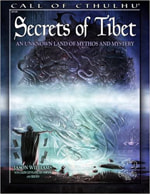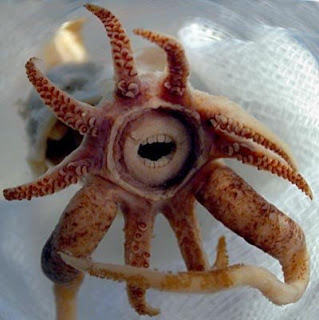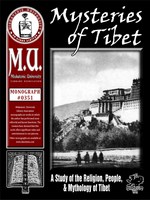
Monográfico MULA (Miskatonic University Library Association).
Este suplemento es una guía para ambientar y jugar partidas en el Tibet. Incluye un escenario.

The story of Tibet is as much about the country as it is about its people, with the highest points on earth, areas that are nearly impossible to reach without modern technology and with malevolent gods and monsters lurking under every rock.
| ▲Volumen▼ | ▲Editorial▼ | ▲Año▼ | V | D |
|---|---|---|---|---|
Secrets of Tibet - An Unknown Land of Mythos and Mystery | Chaosium | 2013 | — | 3 |
| Página 1 |
Muy útil si alguien ¿todavia? está pensando dirigir "La semilla de Azathoth". Por lo demás, mucho blablablá para el raquítico escenario que incluye (de 7 páginas ![]() ).
).
g.
Lo que voy a copiar no es de este MULA, sino del "Secrets of Tibet" ese que han remozado para la séptima. Página 7:
One human tribe called these creatures the M’and Ybula and eventually fled westward ending up on the Atlantic coast of Europe along what is now the border area of Spain and France. These people are today as the Basques, in whose language the word mandíbula means cephalopod.
Me hace dudar un poco de lo que estamos aprendiendo en el rol sobre otras culturas.
Ninguna duda, lo compro de inmediato.
Esto pone a Esculapio0 como descendiente directo de esa tribu y heredero de un conocimiento prohibido... ![]()
Si hombre, mi memoria da asco pero Lovecraft o Howard ya tenían algún relato que ligaba algo de los mitos con el País Vasco, ¿no? ![]()
Belknap Long en Error en tag [LINK]: URL externa., y está Error en tag [LINK]: URL externa. de Lovecraft, ambientada por Pamplona, pero no es un relato propiamente dicho.
La idea de un cefalópodo con mandíbulas mola.

Saludos,
Entro
La palabra mandibula no existe en vascuence.
Cefalópodo se dice, evidentemente, zefalopodo... los antiguos vascones no andaban metidos en categorizaciones de reinos animales...
Mecachis! Y yo que pensaba que sería Kthufalhuorriak, o algo así... ![]()
| Página 1 |

